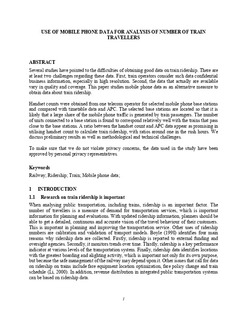| dc.contributor.author | Sørensen, Anette Østbø | |
| dc.contributor.author | Bjelland, Johannes | |
| dc.contributor.author | Bull-Berg, Heidi | |
| dc.contributor.author | Landmark, Andreas D. | |
| dc.contributor.author | Akhtar, Muhammad Mohsin | |
| dc.contributor.author | Olsson, Nils | |
| dc.date.accessioned | 2019-11-13T07:38:16Z | |
| dc.date.available | 2019-11-13T07:38:16Z | |
| dc.date.created | 2018-06-21T09:32:41Z | |
| dc.date.issued | 2018 | |
| dc.identifier.citation | Journal of Rail Transport Planning & Management. 2018, 8 (2), 123-144. | nb_NO |
| dc.identifier.issn | 2210-9706 | |
| dc.identifier.uri | http://hdl.handle.net/11250/2628018 | |
| dc.description.abstract | Several studies have pointed to the difficulties of obtaining good data on train ridership. There are at least two challenges regarding these data. First, train operators consider such data confidential business information, especially in high resolution. Second, the data that actually are available vary in quality and coverage. This paper studies mobile phone data as an alternative measure to obtain data about train ridership. Handset counts were obtained from one telecom operator for selected mobile phone base stations and compared with timetable data and APC. The selected base stations are located so that it is likely that a large share of the mobile phone traffic is generated by train passengers. The number of units connected to a base station is found to correspond relatively well with the trains that pass close to the base stations. A ratio between the handset count and APC data appear as promising in utilizing handset count to calculate train ridership, with ratios around one in the rush hours. We discuss preliminary results as well as methodological and technical challenges. To make sure that we do not violate privacy concerns, the data used in the study have been approved by personal privacy representatives. | nb_NO |
| dc.language.iso | eng | nb_NO |
| dc.publisher | Elsevier | nb_NO |
| dc.rights | Attribution-NonCommercial-NoDerivatives 4.0 Internasjonal | * |
| dc.rights.uri | http://creativecommons.org/licenses/by-nc-nd/4.0/deed.no | * |
| dc.subject | Railway | nb_NO |
| dc.subject | Ridership | nb_NO |
| dc.subject | Train | nb_NO |
| dc.subject | Mobile phone data | nb_NO |
| dc.subject | Smart cards | nb_NO |
| dc.subject | Transportation | nb_NO |
| dc.subject | Fare collection | nb_NO |
| dc.subject | Mobile phones | nb_NO |
| dc.subject | Technical challenges | nb_NO |
| dc.title | Use of mobile phone data for analysis of number of train travellers | nb_NO |
| dc.title.alternative | Use of mobile phone data for analysis of number of train travellers | nb_NO |
| dc.type | Journal article | nb_NO |
| dc.type | Peer reviewed | nb_NO |
| dc.description.version | submittedVersion | nb_NO |
| dc.rights.holder | © 2019 Elsevier B.V. All rights reserved. This is the authors' accepted and refereed manuscript to the article. Released with a Creative Commons Attribution Non-Commercial No Derivatives License. The final publication is available at https://doi.org/10.1016/j.jrtpm.2018.06.002 | nb_NO |
| dc.subject.nsi | VDP::Samfunnsvitenskap: 200 | nb_NO |
| dc.source.pagenumber | 123-144 | nb_NO |
| dc.source.volume | 8 | nb_NO |
| dc.source.journal | Journal of Rail Transport Planning & Management | nb_NO |
| dc.source.issue | 2 | nb_NO |
| dc.identifier.doi | 10.1016/j.jrtpm.2018.06.002 | |
| cristin.unitcode | 7401,60,20,0 | |
| cristin.unitcode | 7401,60,55,0 | |
| cristin.unitname | Anvendt økonomi | |
| cristin.unitname | Teknologiledelse | |
| cristin.ispublished | true | |
| cristin.fulltext | preprint | |
| cristin.qualitycode | 1 | |

